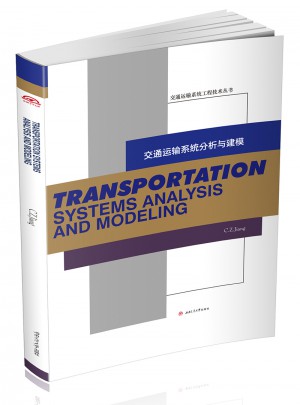

本书首先重新定义了交通系统,针对交通运输供给系统进行分析,特别是基于运输成本和交通流量的关系,通过交通流理论、效用函数理论等对交通运输系统用户行为以及客运与货运规律进行数学建模,其中包括交通运输网络静态和动态均衡模型,后介绍如何通过数据对已经建立的模型校正。本书适合相关专业本科、研究生及相关的研究人员参考。
蒋朝哲: 西南交通大学交通运输工程博士后,副教授;加拿大滑铁卢大学土木与环境工程系博士后,副研究员。主要研究方向包括系统决策理论与方法,交通运输系统工程,大数据在交通中的应用,城市交通排放(PM2.5)等领域。出版专著教材10余部,发表学术论文60余篇,其中被SCI,EI,ISTP收录近20余篇,主持主研国家自然科学基金、国家社科基金等国家省部级以及加拿大国家和省部级课题20余项。
CONTENTS
Part A Transportation Systems Analysis and Modeling Process 1
Chapter 1 Introduction to Transportation Systems 1
1.1 Definitions 1
1.1.1 Preliminary Concepts of Transportation Systems 1
1.1.2 Components of Transportation Systems 2
1.1.3 Relationship Between Transportation Systems and Activity Systems 5
1.2 Transportation System Identification 6
1.2.1 Relevant Spatial Dimensions 6
1.2.2 Relevant Temporal Dimensions 10
1.2.3 Relevant Components of Travel Demand 14
1.3 Macroscopic Measures of a Traffic Stream 17
1.3.1 Fundamental Parameters of Traffic Flow 17
1.3.2 Derived Characteristics 21
1.3.3 Time-space diagram 23
1.3.4 Fundamental Relationship 25
Chapter 2 Transportation Systems Analysis Framework 29
2.1 Background of the Current Transportation Environment Changing 29
2.2 Basic Premise of a Transportation System 29
2.3 Interrelationship of Transportation and Activity System 30
2.4 Intervening Transportation/Activity/Flow (TAF) System 31
2.5 Prediction of Transportation Flows 33
Chapter 3 Transportation Systems Mathematical Modeling Fundamentals 35
3.1 The Function of Mathematical Modeling 35
3.2 General Assumption for Transportation Systems Modeling 36
3.2.1 Physical and Functional Delineation Assumption 36
3.2.2 Spatial Discretization Assumption(Zoning) 36
3.2.3 Identification of Relevant Transportation Services 36
3.2.4 Identification of Relevant Model Periods 36
3.2.5 Withinperiod Variability Assumption 36
3.3 Mathematical Models Family Structure for Transportation System 37
3.4 Supply Models Simulating Transportation Systems 37
3.5 Demand Models Simulating Transportation Systems and Activity 38
3.6 Network Demand-Supply Interaction Modeling 38
Part B Transportation Supply Analysis and Modeling 42
Chapter 4 Macroscopic Traffic Stream Modeling 42
4.1 Introduction 42
4.2 Greenshield’s Macroscopic Stream Model 43
4.3 Calibration of Greenshield’s Model 45
4.4 Other Macroscopic Stream Models 46
4.4.1 Greenberg’s Logarithmic Model 46
4.4.2 Underwood’s exponential model 46
4.4.3 Pipes’ Generalized Model 47
4.4.4 Multi-Regime Models 47
4.5 Shock Waves 48
4.6 Macroscopic Flow Models 50
Chapter 5 Microscopic Traffic Flow Modeling 52
5.1 Introduction 52
5.2 Notation for Car Following Modeling 52
5.3 Car Following Models 53
5.3.1 Pipe’s Model 53
5.3.2 Forbes’ Model 54
5.3.3 General Motors’ Model 54
5.3.4 Optimal Velocity Model 54
5.4 General Motor’s Car Following Model 55
5.4.1 Basic Philosophy 55
5.4.2 Follow-the-Leader Model 55
5.5 Simulation Models 57
5.5.1 Applications of Simulation 57
5.5.2 Need for Simulation Models 58
5.5.3 Classification of Simulation Model 58
Chapter 6 Trip Generation Analysis and Modeling 59
6.1 Basic concepts 59
6.2 Trip Generation Analysis Methods 59
6.3 Regression Analysis Method 62
6.4 Cross-Classification Method 68
6.5 Model Stability over Time 73
6.6 Summary 74
Part C Trip-based Demand Analysis and Modeling 77
Chapter 7 Trip Distribution Analysis and Modeling 77
7.1 Problem Definition 77
7.2 Gravity Models 80
7.3 Calibration of Doubly Constrained Gravity Models 87
7.4 Summary 95
Chapter 8 Modal Split Analysis and Modeling 98
8.1 Introduction 98
8.2 Factors Influencing Mode Choices 99
8.3 Aggregate Mode Choice Models 99
8.4 Disaggregate Choice Models 103
8.4.1 Modeling Framework: the Utility Theory 104
8.4.2 Logit Model 109
8.4.3 Calibration of Logit Models 112
8.5 Disaggregate Choice Models vs Traditional Aggregate Models 124
8.6 Summary 126
Chapter 9 Network Traffic Assignment Analysis and Modeling 129
9.1 Requirements for Network Traffic Assignment 129
9.2 Road Network Models 130
9.3 Shortest Path Algorithms 133
9.4 Route Choice Behaviour Model 139
9.5 Traffic Assignment Methods 141
9.6 Summary 149
References 152
Appendix A Linear Regression Analysis 155
Appendix B Calibrating Logit Models Using Logistic Regression in SPSS 174